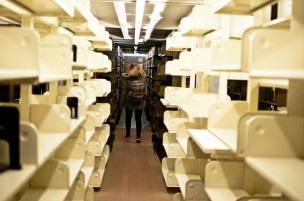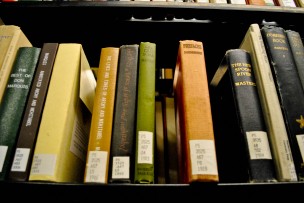
Andrew Ribner/Photography Editor
In an effort to create space for new books and transfer the University Art Library’s collection into Olin Library, the library staff will reduce the size of the University’s print collection by 60,000 volumes. The decision to reduce the size of the University’s approximately one million-volume collection has angered many professors and students, who feel that the books are a valuable resource.
According to University Librarian Pat Tully, space in the Art Library first became limited 20 years ago, causing librarians to move many oversized books over to Olin.
Tully said that weeded books will first be offered to faculty departments in an effort to keep them on campus. If they cannot be placed in faculty departments, she said, they will be sold at University-organized book sales or will be recycled if they are in poor physical condition. According to Tully, the University also decided against the construction of storage space for the excess books for financial and logistical reasons.

Shannon Welch/Assistant Photo Editor
“There is the financial aspect that to build storage for these books would cost an enormous amount of money and then there are the costs of maintaining the space and making sure the environmental controls are okay—all for materials that probably will get little, if any, use,” she said.
According to Professor of History and Director of Israeli and Jewish Studies Magda Teter, several members of the faculty have taken issue with the way that the project is being conducted.
“I am not opposed to the methodical deaccession that happens regularly at all libraries,” Teter said. “What I am objecting to is this wholesale, fast deaccession of six percent of our current collection and to the effect of shrinkage of library space with the Art Library moving to Olin. This means an effective closure of the library space, and limiting its holdings to a closed number of books.”
The project’s blog explains that a book will be considered a candidate for weeding if it was published before 1990, was added to the Wesleyan collection before 2003, has never circulated since 2003 or has circulated less than twice since 1996, is held by 30 or more libraries in the United States, or is held by two or more of the University’s Connecticut partner libraries such as Connecticut College, Trinity College, and University of Connecticut.
Tully also said that given the increasing dependence on electronic materials in academia, it made more sense to conserve financial resources rather than use them on the construction of storage space.
“Right now, electronic books are useable in a variety of situations, but they’re going to become much more useable,” she said. “At some point they’re going to be as easy and as natural to use as electronic journal articles are now. Therefore, if we built a huge space to house print books, in 10 to 15 years we might not need that space and we can always use that space for other things such as study areas.”
Teter said that she believes that there is value in maintaining print volumes despite the trend towards using digital sources, especially when considering long-term preservation of the University’s collection.
“It is a mistaken exuberance over the triumph of everything digital—not to mention the fragility of digital data and the potential for outside control,” she said. “With digital access, all you need is power outage. And yes, power may be restored, but in terms of long term preservation, I am not sure we are technologically stable to assure that these digital books will be available to readers years from now. I am not sure you can have a chance encounter with an ebook, but you will have one with a book in the stacks, next to the book you came to get.”
Tully noted that lists of potential materials to be weeded have been submitted to faculty, who can voice their opinions if they believe a book should be kept.
“People have these anecdotes all the time—and it’s really true—that you’re up in the stacks and you’re looking for something and you find something else that is enormously valuable and sometimes it’s something that hasn’t circulated for quite a while,” she said. “That’s why we’re trying to engage the faculty’s help and they’ve been really great in looking over the lists of things that we might need and saying ‘no, no, no, these books are really important, we need to keep these in the stacks.’”
Teter said she believes that the criteria for weeding have disregarded the merit of certain volumes. She suggested that the University should consider acquiring storage space, perhaps in collaboration with other Connecticut universities.
She added that, for certain sources, such as academic journals, digital access should be considered.
Stephen Acerra ’12, who is writing his thesis on the future of books and libraries in the digital age, said that the project was definitely not ideal.
“I think using the number of [circulations] as one of the criteria can be kind of problematic,” he said. “It’s definitely part of the trend of libraries spending less money on print volumes, especially with the rise of the price of academic journals. It’s a very complicated issue and I can’t really pass judgment, but it’s definitely part of a larger trend.”
Comments are closed